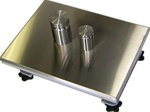 Industrial scales are used to accurately measure weight in virtually every process imaginable. They are used to precisely mix ingredients and components in the chemical industry, for inks and dyes, paints, cleaning compounds, fertilizers, and rubber compounds. Digital scales weigh food additives, coloring agents, flavorings, spices and herbs, and sweeteners within the food industry. Electronic manufacturers utilize electronic scales for compounding materials that are used in the process of semiconductors, encapsulating materials, and passive devices.
Industrial scales are used to accurately measure weight in virtually every process imaginable. They are used to precisely mix ingredients and components in the chemical industry, for inks and dyes, paints, cleaning compounds, fertilizers, and rubber compounds. Digital scales weigh food additives, coloring agents, flavorings, spices and herbs, and sweeteners within the food industry. Electronic manufacturers utilize electronic scales for compounding materials that are used in the process of semiconductors, encapsulating materials, and passive devices.
In all of these cases, it is important for the scale to be as accurate as possible. But as with many situations, there is a tradeoff of cost. Generally, the more accurate the scale is, the more it costs. The most commonly used industrial scales generally incorporate strain gage load cells. These cells typically are designed to act as an excellent spring. They are usually made from a type of metal that is chosen for its spring characteristics. These metals include aluminum, steel or stainless steel. The metal is machined into a shape that it allows it to bend a small amount when a load is placed on the scale platform. When that load is removed, the metal should spring back into exactly its original position. If more load is placed on the platform, the metal spring should bend precisely in the ratio of the applied load.
Of course, no spring is perfect. It will not bend in a way that is perfectly proportional to the weight placed on the digital scale. Once the load is on the platform, the load cell will continue to bend just a little more, as the molecules of metal undergo a very small amount of plastic deformation. When the item is removed from the scale, the load cell will have a slight inaccuracy as to the position to which it returns.
Electronic devices called strain gages are used to measure the amount of stress or strain that the load cell experiences. The strain gage is actually a very thin pattern of metal foil, usually made from an alloy of nickel. This pattern has a value of resistance, so the strain gage can considered to be a resistor. The strain gage is carefully glued onto the load cell spring element using a very thin layer of adhesive. Unfortunately, even a very thin glue line will still cause inaccuracy when the load cell bends. Furthermore, the load cell must accept a fairly significant amount of stress or strain to cause a reasonable change in resistance in the strain gage. This will add to error terms in the load cell, such as hysteresis, non linearity and creep.
A new technology has been invented by Arlyn Scales that uses solid state Surface Acoustic Wave technology, known as SAW scales. Metal load cells are still used, but the SAW devices do not measure stress or strain, but instead measures displacement. The amount of displacement required is very small. So the stress on the load cell is only a very small fraction of that in a standard strain gage load cell. This allows a remarkable reduction in the error terms that are normally seen with load cells.
SAW load cells rely on two SAW transducers. The first is a transmitter, which is fabricated from a metalized pattern on a semiconductor substrate. This produces a bulk wave, or surface acoustic wave, which travels down the length of the substrate. The second transducer is identical to the first, but is used as a receiver. The two substrates are placed in parallel to each other, with just a very small air gap between them. As the acoustic wave travels down the first substrate, an identical wave is induced on the second. This wave is detected by the receiver pattern. This received signal is then amplified, and fed back to the transmitter. If the gain is high enough, this causes a self running oscillation. The frequency of oscillation is dependent on the distance between the transmitter and receiver. As the weight on the scale platform changes, the load cell will bend, the distance between the substrates will change, and the frequency of oscillation will change.
Industrial scales built with SAW technology are twenty times more accurate than strain gage types. These ultra precision scales may be used as bench scales, parts counting scales or cylinder scales. Digital scales of this type are provided with digital output ports, so the ultra precision data may be sent to computers or printers. SAW electronic scales are slightly more expensive than regular industrial scales, but much less expensive than force motor technology.

